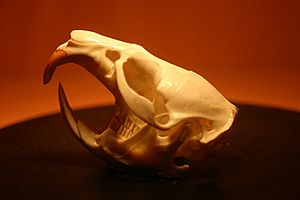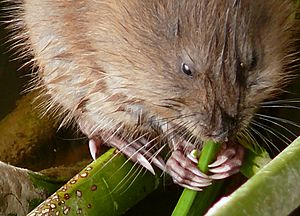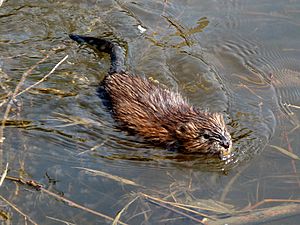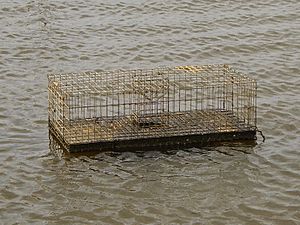Muskrat facts for kids
Quick facts for kids MuskratTemporal range: Recent
|
|
|---|---|
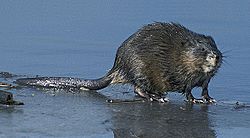 |
|
| Conservation status | |
| Scientific classification | |
| Kingdom: | |
| Class: | |
| Order: | |
| Superfamily: | |
| Family: | |
| Subfamily: |
Arvicolinae
|
| Tribe: |
Ondatrini
|
| Genus: |
Ondatra
|
| Binomial name | |
| Ondatra zibethicus |
|
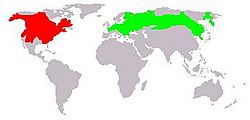 |
|
| Muskrat range (native range in red, introduced range in green. Introduced range in South America not shown.) | |
Muskrats are rodents that live near water. You can find them in freshwater and saltwater marshes, lakes, ponds, and streams. They often build dome-shaped houses in marshes. These houses are made of plants. They protect the muskrat from animals that want to eat them. The only way into the house is underwater. Some muskrats also live in burrows dug into riverbanks. Muskrats are amazing swimmers but move slowly on land.
Muskrats are originally from North America. But they have also been brought to Europe and Asia. Now, they live wild in those places too. Muskrats get their name from a strong smell they can make. This smell comes from special glands.
Contents
What Does a Muskrat Look Like?
An adult muskrat is about 40 to 70 centimeters (16 to 28 inches) long. Half of this length is its tail! They weigh from 0.6 to 2 kilograms (1.3 to 4.4 pounds). This makes them much bigger than a brown rat. Muskrats are also the largest members of their animal family, called Cricetidae. This family includes voles and lemmings. Muskrats are smaller than beavers, but they often live in the same places.
Muskrats have short, thick fur. It is usually medium to dark brown or black. Their belly fur is a bit lighter. This helps them blend in with their surroundings. As they get older, their fur can turn partly gray. Their fur has two layers. This helps keep them warm in cold water. Muskrats have long tails covered with scales, not hair. Their tails are slightly flat from top to bottom. This unique shape helps them swim. When they walk on land, their tails drag. This makes their tracks easy to spot.
Muskrats spend most of their time in the water. They are very good at living a watery life. They can swim underwater for 12 to 17 minutes! Their bodies are special, like those of seals and whales. They are not as sensitive to carbon dioxide buildup as other mammals. They can also close their ears to keep water out. Their back feet are partly webbed. But their tails are the main way they push themselves through the water.
Where Do Muskrats Live?
Muskrats live across most of Canada and the United States. You can also find them in a small part of northern Mexico. They were brought to Europe in the early 1900s. Now, they are an invasive species in parts of northwestern Europe. This means they spread quickly and can cause problems. They mostly live in wetlands. These are areas in or near salty or fresh water. This includes rivers, lakes, or ponds. You won't find them in Florida. Another animal, the round-tailed muskrat, lives there instead.
Muskrat numbers naturally go up and down. When there are many muskrats, they can eat a lot of plants in wetlands. They are important for shaping the plants in prairie wetlands. They also choose certain plants to eat. This changes which plant species are common in many wetlands. Alligators are a big natural predator of muskrats. This might be why muskrats are not found in Florida.
Many wetland homes have been lost because of human activity. But new muskrat homes have been made by building canals and irrigation channels. So, muskrats are still common and widespread. They can even live near streams with sulfur water from coal mines. Fish and frogs might die in these streams. But muskrats can still live well there.
Muskrat Behavior
Muskrats usually live in groups. These groups have a male, a female, and their young. In the spring, muskrats often fight. They fight over their territory and for partners. Many muskrats get hurt or even die in these fights.
Muskrat families build nests. These nests protect them and their babies from cold and from predators. In streams, ponds, or lakes, muskrats dig burrows into the bank. The entrance to these burrows is underwater. These entrances are about 6 to 8 inches (15 to 20 cm) wide. In marshes, muskrats build "push-ups." These are made of plants and mud. Push-ups can be up to 3 feet (90 cm) tall. In snowy places, muskrats keep the openings to their push-ups closed. They plug them with plants and replace the plug every day. Some muskrat push-ups get washed away in spring floods. They have to be rebuilt each year. Muskrats also build feeding platforms in wetlands. They help keep open areas in marshes. This provides good homes for water birds.
Muskrats are most active at night. They also like to be active near dawn and dusk. They eat plants like cattails and other water plants. They do not store food for winter. But sometimes, they eat the inside parts of their push-ups. About 95% of their diet is plants. But they also eat small animals. These include freshwater mussels, frogs, crayfish, fish, and small turtles. Muskrats follow paths they make in swamps and ponds. When the water freezes, they keep following their paths under the ice.
Muskrats are an important food source for many other animals. These include mink, foxes, coyotes, wolves, lynx, bears, eagles, snakes, alligators, and large owls and hawks. Otters, snapping turtles, and large fish like pike eat baby muskrats. Caribou and elk sometimes eat the plants from muskrat push-ups in winter. This happens when other food is hard to find for them. In places where muskrats were brought, like the former Soviet Union, the golden jackal is their biggest predator.
Muskrat Reproduction and Life Cycle
Muskrats, like most rodents, have many babies. Females can have two or three litters (groups of babies) each year. Each litter has six to eight young. The babies are born small and hairless. They weigh only about 22 grams (0.78 ounces). In warmer places, young muskrats grow up in six months. In colder northern places, it takes about a year. The number of muskrats in an area seems to follow a pattern. Their population goes up and then drops sharply over six to 10 years. Other rodents, like lemmings, have similar population changes.
Muskrats and Humans
Native Americans have always thought muskrats were very important animals. Some people even try to guess how much snow will fall in winter. They do this by watching how big muskrat lodges are built and when they are built.
In some Native American creation myths, the muskrat is a hero. It dives to the bottom of the first ocean. It brings up mud to create the Earth. Other animals had tried and failed.
Muskrats have also been a food source for people in North America.
Muskrat fur is very warm. It is best for trapping in early December in northern North America. In the early 1900s, trapping muskrats for their fur became a big business there. At that time, the fur was cut and dyed in a special way. It was sold widely in the US as "Hudson seal" fur. Muskrats were brought to Europe then for their fur. They spread across northern Europe and Asia.
In some European countries, like Belgium, France, and the Netherlands, muskrats are seen as a pest. Their digging damages the dikes and levees. These low-lying countries need these structures to protect them from floods. So, in these countries, muskrats are trapped, poisoned, and hunted. This helps keep their numbers down. Muskrats also eat corn and other farm and garden crops that grow near water.
Royal Canadian Mounted Police winter hats are made from muskrat fur.
Images for kids
See also
 In Spanish: Rata almizclera para niños
In Spanish: Rata almizclera para niños



